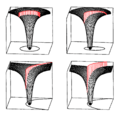Elliptical orbit facts for kids
In astronomy, an elliptical orbit is when one object, like a planet or a star, moves around another in an oval shape. Think of it like a squashed circle! This special path is followed by many things in the universe, including our own Moon as it goes around the Earth, and all the planets as they travel around the Sun. These movements follow important rules called Kepler's Laws, which help us understand how objects orbit in space.
Contents
What is an Elliptical Orbit?
An elliptical orbit is a common way objects move around each other in space. It's different from a perfect circular orbit because the distance between the two objects changes. Sometimes they are closer, and sometimes they are farther apart.
This oval shape happens when the "squashedness" of the orbit, called its eccentricity, is greater than 0 but less than 1. If the eccentricity is 0, the orbit is a perfect circle. If it's 1 or more, the object doesn't orbit in a closed loop; it flies away into space.
Why are Orbits Elliptical?
Objects in space orbit each other because of gravity. Gravity is a force that pulls objects together. When a smaller object, like a planet, is pulled by a larger object, like a star, it starts to fall towards it. But because the planet is also moving sideways, it misses the star and keeps falling around it.
The exact path an object takes depends on its speed and how strong the gravity is. If an object is moving just right, it will settle into an elliptical path. This is described by Kepler's Laws, which were discovered by Johannes Kepler in the early 1600s. His laws explain how planets move around the Sun in these oval-shaped paths.
Examples of Elliptical Orbits
You can see elliptical orbits all around our solar system:
- The Moon travels around the Earth in an elliptical orbit. This means the Moon is sometimes a bit closer to Earth and sometimes a bit farther away.
- All the planets in our solar system, including Earth, orbit the Sun in elliptical paths. These paths are not perfectly circular, though some are very close to being circles.
- Many comets also have very stretched-out elliptical orbits. They spend most of their time far from the Sun, then swing close to it before heading back out into the cold, dark reaches of space.
Other Types of Orbits
While elliptical orbits are very common, objects in space can also follow other paths:
- A circular orbit is a special type of elliptical orbit where the eccentricity is exactly 0. The object stays the same distance from the central body.
- A parabolic trajectory is a path where an object has just enough speed to escape the gravity of the central body. It doesn't come back.
- A hyperbolic trajectory is when an object has too much speed and flies past the central body, never to return.
Images for kids
See also
 In Spanish: Órbita elíptica para niños
In Spanish: Órbita elíptica para niños



